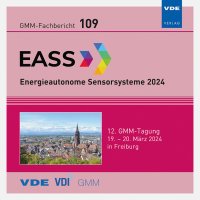Energy demand of typical IIoT sensors and their supply via energy harvesting
Conference: EASS – Energieautonome Sensorsysteme 2024 - 12. GMM-Tagung
03/19/2024 - 03/20/2024 at Freiburg, Germany
Proceedings: GMM-Fb. 109: EASS 2024
Pages: 4Language: englishTyp: PDF
Authors:
Mager, Thomas; Torkmani, Yossof
Abstract:
The digitalisation megatrend Industry 4.0, and the IIoT (Industrial Internet of Things) in particular, require even more powerful and smaller devices such as sensors and actuators. In order to be accepted by the industry, these devices need to be easily integrated into existing systems. This requires devices that can communicate over the air and be powered cordlessly. Only in this way can these devices be integrated cost-effectively and without long interruptions to production. Currently, batteries or rechargeable batteries are the most common source of energy for this type of IIoT device, because they are standardised on the market and replacements are easy to obtain. Uptime is primarily determined by the operating mode of the IIoT device. This means that the data acquisition rate and, in particular, the transmission rate have a significant impact on uptime and, therefore, maintenance costs. The cost of a simple battery change can be as much as $50 or more per IIoT device, depending on where it is located. Therefore, it is important to adapt the operating mode and acquisition rate to the application. This avoids oversampling and reduces the energy demand. The typical data acquisition of IIoT devices can be broken down into 3 key stages. Sleep, Modem Sleep (CPU and ADC on) and Active (CPU and RF-modem on). For a typical chipset with a WiFi modem, such as the ESP32, the power consumption is as follows: 30 muW for Sleep, 30 mW for Modem Sleep and 594 mW for transmitting. Wireless IIoT devices are therefore indispensable for the digital transformation, but they consume a lot of energy to achieve the appropriate broadcasting range and data transmission rates. However, wireless IIoT devices only make sense if they are continuously supplied with energy. Energy harvesting therefore has great potential in this area. But it is not always clear which energy harvesting principle can generate enough energy under the given conditions to power such an application. The aim of this paper is to analyse which energy harvesting principles can provide this amount of energy in the field of Industry 4.0. Based on commercially available solutions, the paper will also show the cost and installation volume of such an energy harvester.


